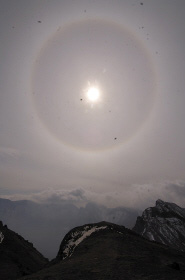Solar halo
Solar halo is an optical phenomenon produced by ice crystals creating colored or white arcs and spots in the sky. Many are near the sun or moon, but others are elsewhere and even in the opposite part of the sky. They can also form around artificial lights in very cold weather when ice crystals, called diamond dust, are floating in the nearby air.
There are many types of ice halos. They are produced by the ice crystals in cirrus clouds located high in the upper troposphere (above 5–10 km, or 3–6 miles). The particular shape and orientation of the crystals is responsible for the type of halo observed. Light is reflected and refracted by the ice crystals and may produce various colors because of dispersion. The crystals behave like jewels, refracting and reflecting sunlight, sending shafts of light in particular directions.
Before meteorology was developed, atmospheric phenomena such as halos were used as part of weather lore, as an empirical means of weather forecasting.
On October 16, 2009, solar halo re-appeared above Changbai Mountain. The moment was captured by Zhang Fuyou, president of Changbai Mountain Culture Research Association, who luckily happened to be climbing the mountain that day. The phenomenon lasted for 19 minutes and 8 seconds, and Zhang took 113 photos all together. According to records, the last time a solar halo appeared above Changbai Mountain was in 1908.
As a result of the recent solar halo, Changbai Mountain received a heavy snow fall the next day and rain poured in nearby regions.
